Squalo was a medium range submarine, leader of the eponymous class (displacement of 937.65 tons on the surface and 1,146.87 tons submerged; other sources speak of 870 or 933 tons on the surface and 1,142.87 submerged, or of standard displacement of 857 tons and in normal load of 920 tons on the surface and 1,125 submerged).
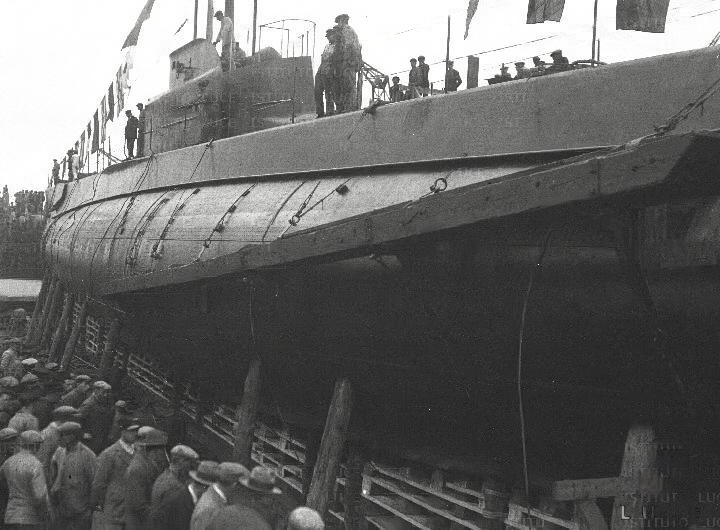
Squalo still on the slip in Monfalcone
(Istituto Luce)
Designed by the general of the Naval Engineers Curio Bernardis, the Squalo class belonged to the single-hulled type with double central bottoms, resistant external hulls (called “Bernardis”, being the main proponent of this type of submarine in Italy) and represented the third stage of the evolution of this type, after the Pisani and Bandiera classes. These three classes had indeed been ordered almost simultaneously, with the Bandiera and Squalo were set even before the completion of the Vettor Pisani, from which they derived, and therefore before being able to fully verify the qualities of the “progenitor” class, which later turned out to be mediocre; the result was that the Bandiera and Squalo had to be modified during construction, to attempt to overcome the drawbacks of the type.
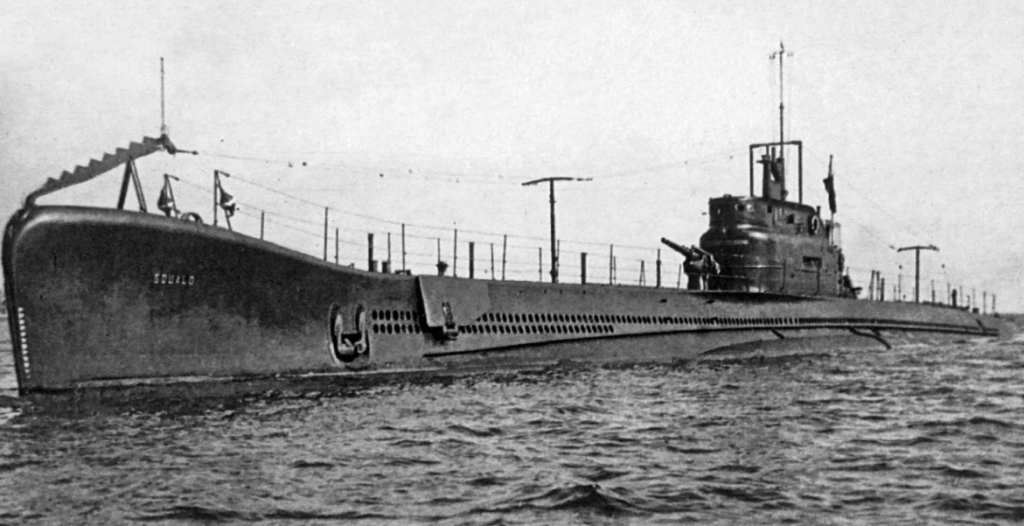
R. Smg. Squalo (Royal Submarine Squalo – (Shark))
Here with the modified bow nicknamed “big nose”
(Photo provided by. Marcello Risolo)
Therefore, having been set up too prematurely (when the construction of the Bandiera had only begun six months earlier), before having tested the actual performance of the previous classes, and despite the modifications necessarily applied during construction, the submarines of Squalo class continued to suffer from the same basic problems that had afflicted the Pisani and Bandiera classes. These problems, immediately highlighted during the sea trials, were a problematic stability issue both on the surface and underwater, which forced the application of external saddle tanks, and seakeeping problems (in particular, tendency to slip into the sea from the bow) that forced the bow to be modified shortly after completion, raising it to insert a self-filling box with the aim of counteracting pitching (giving the class the characteristic “nose” of medium-cruise submarines designed by Bernardis). These modifications (especially the counter-hulls) affected the maximum speed the class, just like on the Pisani and the Bandiera, reducing it by about one and a half knots compared to the design specifications and limiting it to 15 knots on the surface against the 17-18 knots of the more successful later classes.
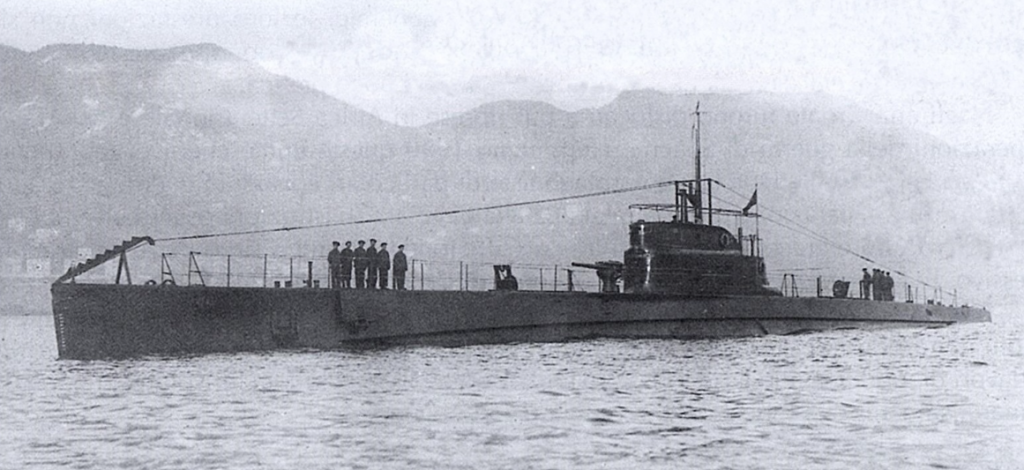
Squalo with the original bow
All things considered, the Squalo class was basically a repetition of the previous Bandiera class, with some improvements that made it more efficient and reliable, so much so that it is believed that with this class the “experimental” period of submarine design in the Italian Navy had come to an end. The similarity between the two classes was such that the Squalo class is sometimes referred to as a “second series” of the Bandiera class, since the modifications received by Squalo class during construction not being such as to represent a significant difference between the two classes. The main differences were the slightly smaller displacement of the Squalo class (by a few tons), the main size, the shape of the conning tower and the arrangement of the machine guns.
Despite the above-mentioned flaws, the performance of the “Squalos” was rated as good overall; in particular, the submarines of the class showed good characteristics during the deployment in the Red Sea in the period 1936-1938, where despite the difficult conditions of that theater they always remained in excellent conditions of efficiency. The Squalo class benefited from a more accurate set-up and the exploitation of the advantages of mass production, making the most of the design and construction experience of the previous Pisani and Bandiera. They were thus the first “Bernardis” to be judged favorably, and in 1940, despite already having a decade of service behind them, they were considered as still having a fair war value. The historian Giorgio Giorgerini wrote in his “Uomini sul fondo” (“Men on the bottom”) that “at last satisfactory submarines were obtained (…) On the whole, they performed well and demonstrated, in the pre-war period, that they could operate efficiently in the harsh conditions (…) of the Red Sea. In war they could be employed in offensive tasks as well as transport“; on the other hand, Bagnasco and Brescia in “Sommergibili Italiani 1940-1943” (“Italian submarines 1940-1943”) state that the performance of Squalo class was not dissimilar to that of the Bandiera, which in turn was judged, after the aforementioned modifications, “acceptable, even with a maximum speed contained in relation to the installed power”.
The propulsion system for surface navigation consisted of two two-stroke, six-cylinder, reversible diesel engines FIAT Q 426 of 3,000 HP (1,500 per engine; 2,208 kW overall) that allowed a maximum speed of 15.1 knots, with a range of 1,820 nautical miles at this speed and 5,650 miles at 8 knots. The propulsion for underwater navigation consisted of two 1,300 HP CRDA electric motors (650 HP per engine) that made it possible to reach 8.2 knots, with a diving range of seven miles at this speed (autonomy actually lower than that of the previous Pisani and Bandiera: these two classes had in fact a diving range of 8.8 miles at 8.2 knots) and one hundred miles at 3 knots. The batteries were composed of two sections of 56 batteries each, capable of producing 4,270 amperes in one hour, 6,380 in three hours, 8,400 amperes in ten hours and 9,350 in twenty hours (in truth, inferior performance to those of the previous Pisani and Bandiera classes).
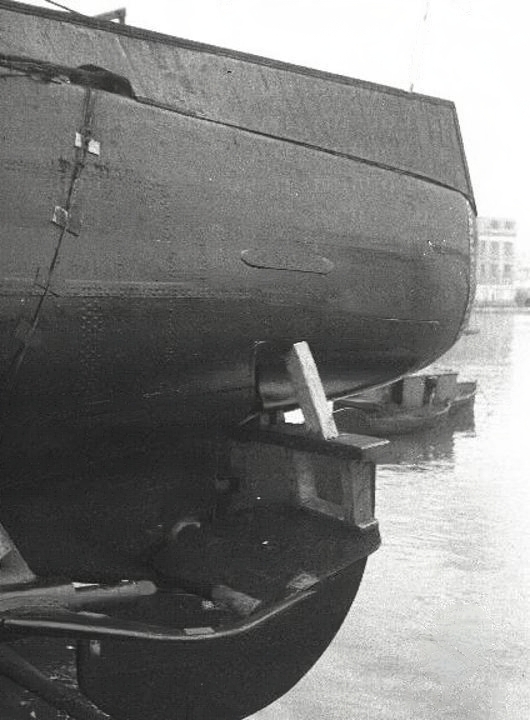
Details of the stern section
(Istituto Luce)
The armament consisted of eight 533 mm torpedo tubes (four at the bow and as many at the stern) with a reserve of twelve torpedoes (half at the bow and half at the stern), a 102/35 mm Schneider-Armstrong 1914-1915 gun with a reserve of 150 rounds (initially in a shielded ready-use stowage that formed a continuation of the conning tower, which proved impractical and was soon replaced by a more traditional “in the open” arrangement), and two single 13.2/76 mm machine guns with a supply of 3,000 rounds. The testing depth was 90 or 100 meters.
While in 1942 Delfino and Narvalo underwent work to reduce the voluminous conning tower, to better adapt it to the conditions of the war in the Mediterranean, Squalo kept its original version – the only modification was the shortening of the periscope jackets – until its decommissioning and demolition.
During World War II, Squalo completed 28 offensive/exploratory patrols and 14 transfers from June 10th, 1940 to April 30th, 1942, covering a total of 18,800 miles on the surface and 2754 submerged, and spending 170 days at sea. From 1 May 1st, 1942 to 1943 it carried out 121 training sorties for the Submarine School in Pula, as well as some anti-submarine patrols in the Upper Adriatic (the latter, unlike the training outings, are part of the aforementioned 42 missions in total). During the co-belligerence between Italy and the Allies (September 1943-1945) the boat carried out training activities for the benefit of Italian anti-submarine units.
Squalo ‘s motto was “Coeco sub gurgite unum sidus Italia” (“From the blind whirlpool I see only one star, Italy”).
Brief and partial chronology
October 10th, 1928
Laid out in Shipyard of Monfalcone (Trieste) (construction number 207).
January 15th, 1930
Launched at the Shipyard in Monfalcone (Trieste).
October 6th, 1930
The boat entered service (other source gives the date of October 10th) and was assigned to the II Submarine Squadron of medium range, based in La Spezia, which it formed together with the simil;ar boats Tricheco, Narvalo and Delfino.
1932
Squalo carried out training cruises along the Italian coasts, in addition to the usual periodic training trips.
Mid-thirties
Sailor Pietro Venuti, future Gold Medal for Military Valor, served aboard the Squalo .
1934
The submarine was transferred to Naples, and it formed the IV Submarine Squadron along with the three boats of the same class.
1935-1936
Squalo alternated periods of deployment in Italian bases with long stays in Tobruk.
December 14th, 1936
Lieutenant Ugo Botti took command.
1936-1938
Squalo was in Massawa (Eritrea), in the Red Sea, until spring 1938. During this two-year period, Squalo was used for training in the waters of Italian East Africa (AOI), in order to ascertain whether the units of the class were suitable for activity in warm seas. The results were judged to be positive. (According to another source, Squalo was sent to Massawa only in 1937, along with the Dolfino, replacing Narvalo and Tricheco who had been stationed there in 1936).
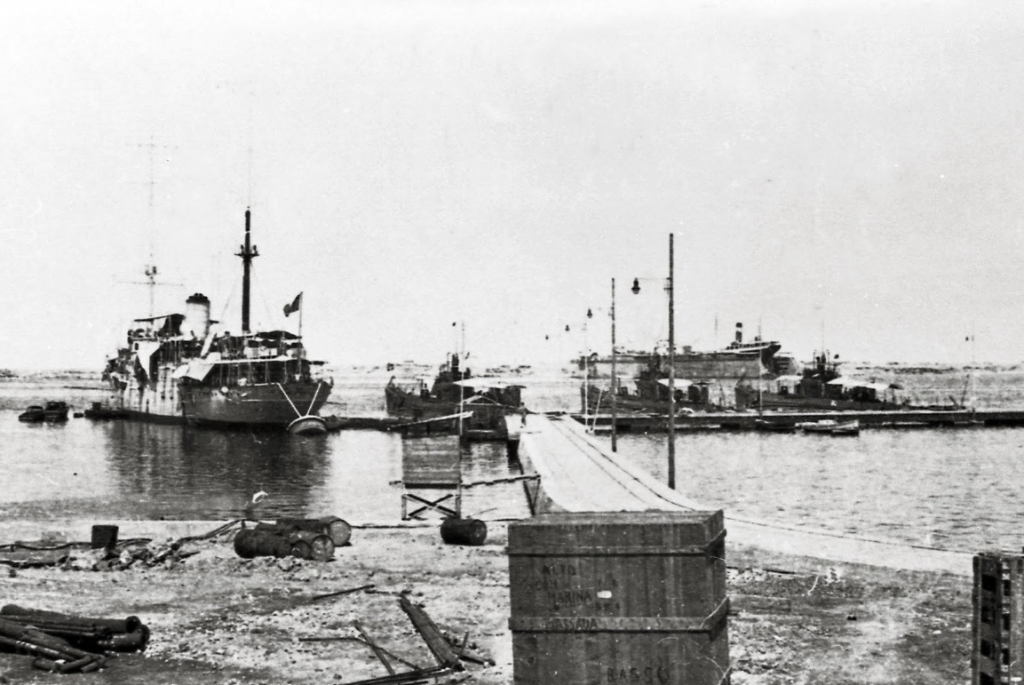
The submarine Squalo (center) together with its twin boat Delfino (right), the submarine Fratelli Bandiera (left), and the colonial ship Eritrea (left) in Massawa
(Photo Coll. Guido Alfano)
1938
Back in Italy, the boat formed the XXXIII Submarine Squadron (III Grupsom), based in Messina, along with Delfino, Narvalo and Tricheco. The submarines of the Squadron were sent in turn to the Upper Adriatic for work and verifications carried out in the torpedo factory in Rijeka.
May 5th, 1938
Squalo took part in the naval parade “H” organized in the Gulf of Naples for Adolf Hitler’s visit to Italy. Most of the Italian fleet took part in the review: the battleships Giulio Cesare and Conte di Cavour, the seven heavy cruisers of the I and III Divisions, the eleven light cruisers of the II, IV, VII and VIII Divisions, seven “light explorers” of the Navigatori class, eighteen destroyers (the Squadrons VII, VIII, IX and X, plus the Borea and the Zeffiro), thirty torpedo boats (the Squadrons IX, X, XI and XII, plus the old Audace, Castelfidardo, Curtatone, Francesco Stocco, Nicola Fabrizi and Giuseppe La Masa and the four “escort notices” of the Orsa class), as many as 85 submarines of the Submarine Squadron under the command of Admiral Antonio Legnani, and 24 MAS (Squadrons IV, V, VIII, IX, X and XI), as well as the training ships Cristoforo Colombo and Amerigo Vespucci, Benito Mussolini’s yacht, the Aurora, the royal ship Savoy and the target ship San Marco.

Squalo during the naval parade “H”
(From“I sommergibili italiani” di Mario Paolo Pollina, USMM)
The Submarine Squad was the protagonist of one of the most spectacular moments of the parade, in which the 85 boats carry out a series of synchronized maneuvers: first, arranged in two columns, at 1.15 PM they pass opposite direction between the two naval squadrons proceeding on parallel routes; Then, at 1:25 PM, all submarines made a simultaneous mass dive, proceeded for a short distance in immersion and then emerged simultaneously and executed a salvo of eleven shots with their respective guns.
March 19th, 1939
Squalo collided with the submarine Santorre Santarosa, which suffered damage to the propeller shaft and the breakage of the horizontal rudder guards. This was followed by a period of work in drydock.
1940
Stationed in Leros, and under the command of Lieutenant Giuseppe Migeca, Squalo became part of the LI Submarine Squadron (V Grupsom of Leros), again along with Delfino, Narvalo and Tricheco.
June 10th, 1940
Upon Italy’s entry into World War II, Squalo was part of the LI Submarine Squadron based in Leros, with Delfino, Narvalo and Tricheco. Under the command of Lieutenant Giuseppe Migeca, it carried out its first war patrols in the eastern Mediterranean, without encountering enemy units. Subsequently, (1941-1942) it was used for ambush missions in the Strait of Sicily.
June 1940
After the outbreak of war, Squalo was sent to lie in wait in the North Aegean, off the Dardanelles.
September 17th, 1940
The boat was sent to patrol the waters north of Crete, along with the submarines Beilul, Delfino and Narvalo: It did not encounter British ships.
April 1941
In the second half of the month, Squalo was sent to lie in wait off the Egyptian coasts (Gulf of Sollum and Marsa Matruh).
May 20th, 1941
Squalo was sent to the waters between Crete, Sollum and Alexandria (Egyp)t, together with numerous other submarines (Uarsciek, Walrus, Topaz, Fisalia, Adua, Malachite, Dessiè, Sirena and Smeraldo), to support the German assault against Crete (Operation “Merkur”). During this mission, the crew spotted a British naval formation from a great distance but was unable to attack.
July 23rd, 1941
Squalo, under the command of Lieutenant Ludovico Grion, was sent to lie in wait in the waters of Cyrenaica, off Ras Azzaz (about fifty miles east of Tobruk),
July 24th, 1941
In the evening, Squalo sighted from a short distance, north of Ras Azzaz and northeast of Tobruk, a unit that was identified as a British tanker ” type War…” of 10,000-11,600 GRT (probably with a strong overestimation of the tonnage), sailing on a westerly course (it was probably a unit used to supply the garrison of Tobruk, surrounded and besieged by Axis troops for more than three months).
At 11.01 PM, in position 32°20′ N and 24°53′ E, Squalo launched two torpedoes from about 1,000 meters against the enemy ship. On board the submarine two loud explosions are heard after the expected torpedo travel time, and it was therefore believed to have damaged it, but when shortly after Squalo emerges to better ascertain the result of the attack the ship, helped by the darkness and mist, had disappeared. There is no evidence from the British side of this attack; The identity of the attacked ship also remains a mystery.
July 30th, 1941
Sighting two British destroyers south of Crete, Squalo tried unsuccessfully to attack them, after which it is was then subjected to anti-submarine hunting with abundant launch of depth charges, from which, however, it managed to escape without being damaged, thanks to the shrewd evasive maneuvers ordered by Commander Grion.

Squalo and other submarine in a picture probably dating to before the conflict
For the alleged torpedoing of the tanker, Commander Grion would be decorated with the Bronze Medal for Military Valor (“Commander of a submarine, during a war mission, conducted with high fighting spirit and serene daring, torpedoed an enemy armed tanker of 11,000 tons, causing its probable sinking. He then decisively attacked a section of destroyers and, subjected to violent hunting, with skilful maneuvers managed to disengage”). For a similar reason, 24 other members of the crew of Squalo would receive the War Cross for Military Valor (chief engineer, captain of the Naval Engineers Silvano Lupidi; second commander, sub-lieutenant Gennaro Savino; midshipman Aurelio Schiano di Pepe; sub-lieutenant of the Naval Engineers Bruno Miani; aspiring midshipman Antonio De Natale; chief torpedoman first class Pio Albalunga; chief mechanic first class Mario Pieresca; chief of the engineers), second-class mechanic Nazzareno Storani; third class helmsman, Ottorino Marzotto; chief torpedoman third class Adolfo Botti; Chief Mechanic Third Class Mario Guida; second chief radio telegraphist Achille Mariotto; sergeants electrician Angelo Callinella and Carlo Stradella; under-helmsman Giusepep Sanalitro; sub-chief gunner, gunner, Domenico Arena; sub-chief radio telegraphist Luigi Baldessari; second chief torpedoman Rosario Onorato; sailor Giovanni Velotti; torpedoman Vincenzo Iandolo and Armando Scaranari; stokers Antonio Pacor, Ettore Capridossi and Umberto Cassani).
August 24, 1941
Squalo and the submarines Tricheco, Topazio and Fratelli Bandiera formed a barrage in the Strait of Sicily together with 13 MAS, to intercept an alleged British convoy sailing from Gibraltar to Malta, following the sighting of large British naval forces (Force H with the battleship H.M.S. Nelson, the aircraft carrier H.M.S. Ark Royal, the light cruiser H.M.S. Hermione, the destroyers H.M.S. Encounter, H.M.S. Fury, H.M.S. Forester, H.M.S. Foresight and H.M.S. Nestor) had set sail from Gibraltar (August 21st) and headed east. In reality, there was no convoy: the British have launched Operation “Mincemeat”, which consists of sending the fast minelayer H.M.S. Manxman (which left alone on August 22nd so as not to attract attention) off the coast of Livorno, to lay minefields in those waters, and in air attacks launched by H.M.S. Ark Royal against targets in Sardinia (industrial plants and cork forests in the northern part of the island), in order to dissuade Francisco Franco’s Spain from entering the war on the side of the Axis, showing the Royal Navy’s ability to strike the enemy even at home.
September 26th, 1941
Squalo patroled the waters north of Capo Ferrat and southwest of Sardinia together with Delfino and Fratelli Bandiera, as part of the fight against the British operation “Halberd”, which began on September 24th. The main purpose of the latter was to send to Malta a convoy of supplies (military tanker Breconshire and cargo ships Ajax, City of Lincoln, City of Calcutta, Clan MacDonald, Clan Ferguson, Rowallan Castle, Imperial Star and Dunedin Star, with a total cargo of 81,000 tons of materials), with the direct escort of Force X (formed by the light cruiser cruisers H.M.S. Kenya, H.M.S. Edinburgh, H.M.S. Sheffield, H.M.S. Euryalus and H.M.S. Hermione and the destroyers H.M.S. Cossack, H.M.S. Farndale, H.M.S. Foresight, H.M.S. Forester, H.M.S. Heythrop, H.M.S. Laforey, H.M.S. Lightning, H.M.S. Oribi and H.M.S. Zulu) and also the indirect support, in the first part of the voyage, of Gibraltar’s Force H, three battleships (H.M.S. Rodney, H.M.S. Nelson and H.M.S. Prince of Wales), an aircraft carrier (H.M.S. Ark Royal), five) and nine destroyers (the British H.M.S. Duncan, H.M.S. Fury, H.M.S. Gurkha, H.M.S. Lance, H.M.S. Legion, H.M.S. Lively, Poland’s Garland and Piorun and the Netherlands’ Isaac Sweers).
In addition, secondary operations included the “Halberd” scheme which also include the dispatch of a convoy of three unloaded merchant ships from Malta to Gibraltar (which departed in the night between September 26th and 27th and escorted only by a corvette) and an exit to sea from Alexandria of a portion of the Mediterranean Fleet, for diversionary purposes, all with the protection of eight submarines of the 8th and 10th Flotilla deployed in the areas most likely to pass through the Italian fleet. The main convoy and its escort forces sailed from Gibraltar between September 24th and 25th, regrouping on the morning of the 27th about a hundred miles south of Cagliari.
On the Italian side, however, the real objective of the British was unknown: the Italian commands, given that the reconnaissance had sighted Force H but not the convoy headed for Malta (Supermarina received the first news of the enemy operation at 11.10 am. on September 25th, when it was informed by “Maristat Informazioni” that “N.B. NELSON left yesterday at 6.30 PM for the west with 4 CC. TT. STOP RODNEY raised the ensign admiral alt During the night all Gibraltar naval forces departed with numerous CC escorts. TT. presumably for the Mediterranean STOP The RODNEY would be joined by the NELSON group with the type BELFAST alt Purpose of the mission would be retaliation against the Italian coasts”), thinking that the British intend to launch an air-naval bombardment against the Italian coasts, and at the same time supply Malta with aircraft, while the hypothesis (much more probable) of sending a convoy to Malta was omitted.
In particular, Supermarina assumed that the British wanted to hit population centers in Sardinia in retaliation for the attack conducted a few days earlier (September 20th, 1941) by the X Flotilla MAS against the Gibraltar base, in which the tanker Fiona Shell was sunk and the large motor ship Durham and the military tanker Denbydale were seriously damaged.
And it was precisely with the idea in mind to counter a probable attack against the Italian coasts (“to intervene both in the event that the enemy forces had acted at dawn against Genoa, and in the event that they had acted against Sardinia or in any case were towards the south”) that it was decided to deploy fifteen submarines in various points of the Mediterranean, three of which (Squalo, Delfino, Fratelli Bandiera) were sent to the southwest of Sardinia.
On the morning of September 27th, Supermarina was finally informed of the presence at sea of a British convoy bound for Malta, but by then the British ships had already passed through the ambush sectors assigned to the various submarines, even before the latter reached them. The Submarine Squadron Command (Maricosom) then ordered all submarines to move further south, trying to intercept the British ships during the return voyage, also communicating on the evening of the 27th: “Enemy naval force already attacked and damaged by ARMERA (TN Air Force) STOP In the search and in the attack act with the utmost commitment and precision to inflict on the enemy further and more serious damage possible STOP I am sure that you will show yourselves worthy of the trust he places in you the Navy.” Squalo, for its part, won’t spot anything. On the other hand, five other submarines would be sighted by the enemy forces, of which two (Dandolo and Aradam) will succumb to attack, two (Diaspro and Serpente) attacked unsuccessfully and the fifth, the Adua, would be sunk with all the crew after an unsuccessful attempt to attack a group of destroyers.
The Italian surface fleet, which went out to sea with two battleships (Littorio and Vittorio Veneto), five cruisers (three heavy, Trento, Trieste, and Gorizia, and two light, Muzio Attendolo and Duca degli Abruzzi) and 14 destroyers, returned to base when aerial reconnaissance indicated that Force H was numerically more powerful. The only damage to the British would be inflicted by the Regia Aeronautica, whose torpedo bombers will manage to seriously damage the battleship Nelson and sink the motor ship Imperial Star. Nevertheless, ‘Halberd’ will end on September 30th with all objectives achieved.
September 29th, 1941
Squalo was unsuccessfully subjected to depth charge hunting by British destroyers off Malta.
October 7th, 1941
The sailor Battista Mazzucchelli (21 years old, from Monte Isola) died on board Squalo in the Central Mediterranean. He was the only one of Squalo’s crew to have fallen during the war.
October 17th, 1941
The boat patrolled the waters of Cape Bon together with the Narvalo, forming a barrier in the Strait of Sicily together with the submarines Ambra, Ametista, Corallo, Diaspro, Alagi, Fratelli Bandiera, Serpente, Turchese, Narvalo, and Delfino. However, this barrier did not succeed in hindering the transfer from Gibraltar to Malta of the newly formed British Force K (light cruisers H.M.S. Aurora and H.M.S Penelope and destroyers H.M.S Lance and H.M.S Lively), in charge of attacking the Axis convoys sailing between Italy and North Africa: the British ships reached Valletta unharmed on October 21th.
November 10th, 1941
The boat was sent to patrol the waters east of Gibraltar together with the submarines Turchese, Fratelli Bandiera, Aradam, Onice and Narvalo (according to “Sommergibili italiani 1940-1943” (“Italian submarines 1940-1943”), however, Squalo was sent east of Malta together with Delfino, Tricheco and Luigi Settembrini).
November 22nd and 23rd, 1941
Squalo (Lieutenant Ludovico Grion) was sent to lie in wait south of Capo Passero and east of Malta, to cover the traffic with Libya, together with the twin boats Delfino and Tricheco and other submarines (Corallo and Luigi Settembrini). Its assignment was to spot and report (and if possible attack) any exits at sea by Force K (light cruisers H.M.S Aurora and H.M.S Penelope and destroyers H.M.S Lance and H.M.S Lively) based on the island, already author, on November 9th, of the destruction of the large convoy “Duisburg”, being in progress a large traffic operation towards North Africa. (According to a source, the German B-Dienst reported the departure from Malta of Force K, which had gone out to sea to attack the Italian convoys). Squalo, however, did not spot enemy ships.
November 27th, 1941
Squalo patrolled the waters of southeastern Sicily together with Delfino.
December 13th, 1941
Squalo was sent to patrol the waters south of Malta, together with the submarines Narvalo, Topazio, Veniero and Santarosa, to counter a possible exit into the sea of Force K (light cruisers H.M.S Aurora, H.M.S Penelope and H.M.S Neptune and some destroyers), to protect the operation “M. 41” (which provided for the dispatch of 3 convoys for a total of 8 merchant ships, with the direct escort of 7 destroyers and a torpedo boat as well as the remote escort of three heavy groups and the support of a total of 4 battleships, 5 cruisers, 18 destroyers and two torpedo boats) for the supply of Libya (later aborted as a result of the intense British underwater attacks and the related damage and losses suffered). At the same time, other submarines (Ascianghi and Dagabur) were sent off to the coast of Alexandria to counter a possible sortie by Force B, which was based there.
Force K, under the command of Commodore William Gladstone Agnew, sailed from Malta in opposition to Operation M. 41, joining Force B (light cruisers H.M.S Euryalus, H.M.S Naiad and H.M.S Galatea and destroyers H.M.S Jervis, H.M.S Kingston, H.M.S Kipling, H.M.S Kimberley, H.M.S Griffin, H.M.S Havock, H.M.S Hotspur, H.M.A.S Napier and H.M.A.S Nizam, the last two Australians) which had left Alexandria to search for Italian convoys in the Ionian Sea. However, the British ships were unable to intercept anything, since the convoys was ordered back, so after hours of fruitless searches they embarked on the return navigation to Malta (Force K) and Alexandria (Force B).
December 17th, 1941
Squalo, together with other submarines (Ascianghi, Topazio, Santarosa, Galatea and Dagabur) was deployed in the central-eastern Mediterranean (east of Malta and south of Crete) with exploratory/offensive tasks, in support of the “M. 42” traffic operation, consisting of sending two convoys to Libya with urgent supplies for the Italian-German troops in North Africa (312 vehicles, 3224 tons of fuel and lubricants, 1,137 tons of ammunition, 10,409 tons of miscellaneous materials) with the escort of substantial shares of the battlefleet.
On the afternoon of December 17th, Squalo , lying in ambush off Malta, sighted two British cruisers leaving Valletta, and at 6.15 PM (or 6.45 PM) launched a signal of discovery with which it communicated its sighting, adding that the enemy ships had assumed a course of 140° and a speed of 28 knots (Squalo’s commander’s appreciation of course and speed proved to be quite accurate, as well as the estimation of the enemy’s position at the time of sighting). The sighting was promptly communicated to Admiral Angelo Iachino, commander of the Italian naval squadron at sea in support of the “M. 42” operation. The ships sighted by Squalo are actually a cruiser, H.M.S Neptune, and two destroyers, H.M.S Kandahar and H.M.S Jaguar: they are part of the notorious British Force K and set sail from Malta at 3 PM to try to intercept the Italian convoys, with the order to reach point 32°40′ N and 16°06′ E at 11:00 PM and start from that point, together with the rest of Force K (H.M.S Aurora, H.M.S Penelope, H.M.S Lance, H.M.S Lively) and in cooperation with Vickers Wellington reconnaissance aircraft, the search for the Italian convoy bound for Tripoli.
Operation M. 42, which gave rise to the brief and inconclusive clash that became known as the First Battle of Sirte, ended happily with the arrival of the convoys in Libyan ports. Force K will end up on an Italian minefield off Tripoli, suffering the loss of the H.M.S Neptune and H.M.S Kandahar and the severe damage to the light cruiser H.M.S Aurora.
December 19th, 1941
Squalo was unsuccessfully subjected to depth charge hunting by British destroyers off Malta.
January 22nd through 25th, 1942
The boat was sent between Malta and the Strait of Sicily, along with the submarines Narvalo, Topazio, Santorre Santarosa, Platino and Corallo, to cover the “T. 18” trafficking operation, which sought the sending to Libya of an important convoy with supplies (15,000 tons of materials, 97 tanks, 271 vehicles and 1467 soldiers). An attack by British torpedo planes caused the loss of the troop transport Victoria, which sank with the death of three hundred men, while the other motor ships reached Tripoli unscathed and contributed, with their cargo, to feed the Italian-German counter-offensive that would lead in the following months to the reconquest of Cyrenaica, lost back in December during the British offensive called “Crusader”.
May 1st, 1942
The boat was assigned to the Submarine School in Pula for training duties.

Squalo in Trapani, Sicily. Probably in late January 1924
(From the magazine “Storia Militare”)
May 1942 – July 1943
The boat operated as part of Submarine School of Pula, carrying out a total of 121 training outings as well as some anti-submarine ambushes in the Upper Adriatic.
August 1942
The boat carried out a protective ambush in the Upper Adriatic.
November 1942
Squalo completed another protective ambush in the Upper Adriatic.
July 1943
Faced with the precipitation of events – Sicily invaded by Anglo-American forces, the Italian submarine fleet decimated by increasingly heavy losses – Squalo left the Submarine School in Pula and was “recalled” to “front line” service.
September 3rd, 1943
The boat left Brindisi at 10.10 PM to relocate to Taranto.
September 5th, 1943
Squalo arrived in Taranto at 7.50 AM.
September 7th, 1943
Squalo (Lieutenant Carlo Girola) sets sail from Taranto at 2.37 PM to reach an ambush sector in the Ionian Sea. Maricosom (the Submarine Squadron Command), having received news of the sighting of the Anglo-American invasion fleet heading towards the coasts of southern Italy, gave the go-ahead for the “Zeta” Plan (drawn up since March 23rd, 1943, for the protection of the coasts of Southern Italy, Sicily and Sardinia with the large-scale use of the remaining underwater forces, modified several times and issued on July 2nd). It consisted in the mass deployment of submarines in those waters, to counter the Allied landings.
As part of the “Zeta” Plan, Squalo was sent to form a barrage in the Ionian Sea (between the eastern coasts of Sicily and Calabria and Cape Santa Maria di Leuca in Puglia) together with seven other submarines (Fratelli Bandiera, Marcantonio Bragadin, Jalea, Zoea, Luigi Settembrini, Onice and Vortece): Onice, Vortice, Settembrini and Zoea had already been deployed there previously, while Squalo, Bandiera, Jalea and Bragadin extend this pre-existing barrier to the Gulf of Taranto. Eight other boats (Brin, Diaspro, Topazio, Alagi, Marea, Galatea, Velella, Platino and Nichelio) were deployed in the Lower Tyrrhenian Sea to cover the coast between the gulfs of Paola and Gaeta, while two others (Giada and Turchese) were sent to the west of Sardinia.
While this was happening, the armistice between Italy and the Allies had already been signed four days prior; but it remains covered by the utmost secrecy, everyone was kept in the dark except for a small inner circle headed by Pietro Badoglio and (TN King) Vittorio Emanuele III. The commander of Maricosom participated to the meeting organized by Admiral Raffaele De Courten, Chief of Staff of the Navy, to explain to the senior commanders the provisions of Memo No. 1, sent to him on September 6th by the Supreme Command, and in which orders were given for an imminent reversal of alliances. The deployment of submarines in the waters of Southern Italy was agreed with the Allied commands in order not to arouse the suspicion of the Germans. The crews were obviously not aware of it, and that of the Velella (commanded by Mario Patanè, the previous commander of the Topazio) would pay with their lives for this absurd situation, torpedoed on September 7th by the British submarine Shakespeare.
September 8th, 1943
The announcement of the armistice between Italy and the Allies surprises Squalo on an offensive mission in the Ionian Sea (other sources, probably erroneous, state that it was in the Lower Tyrrhenian Sea or in the Strait of Sicily).
At 7:50 PM on September 8th, eight minutes after the EIAR (ITN Italian State Radio) announced the news to the nation (the Allies announced it at 6:30 PM, via Radio Algiers), Maricosom issued to all submarines at sea the message “On receipt of this order assume a task exclusively I repeat exclusively exploratory”, followed at 9.10 PM by “Upon receipt of this message cease all hostilities to the accused received”. At 9:50 PM, Maricosom ordered all submarines: “Dive immediately to a depth of 80 meters STOP At 8 AM on the 9th, emerge remaining on the surface with the national flag on the shore and a black pendant at the bow periscope STOP You will receive further orders STOP Acknowledge receipt.”
Commander Girola dello Squalo decided to consult with the commanders of the Bandiera (Lieutenant Commander Scarelli) and the Bragadin (lieutenant Alpinolo Cinti), lurking in contiguous areas. Girola and Cinti decide to reach Augusta, a Sicilian port under British control, while Scarelli sets course for Taranto.
September 10th, 1943
Commander reached the port of Augusta, where he surrendered to the British.
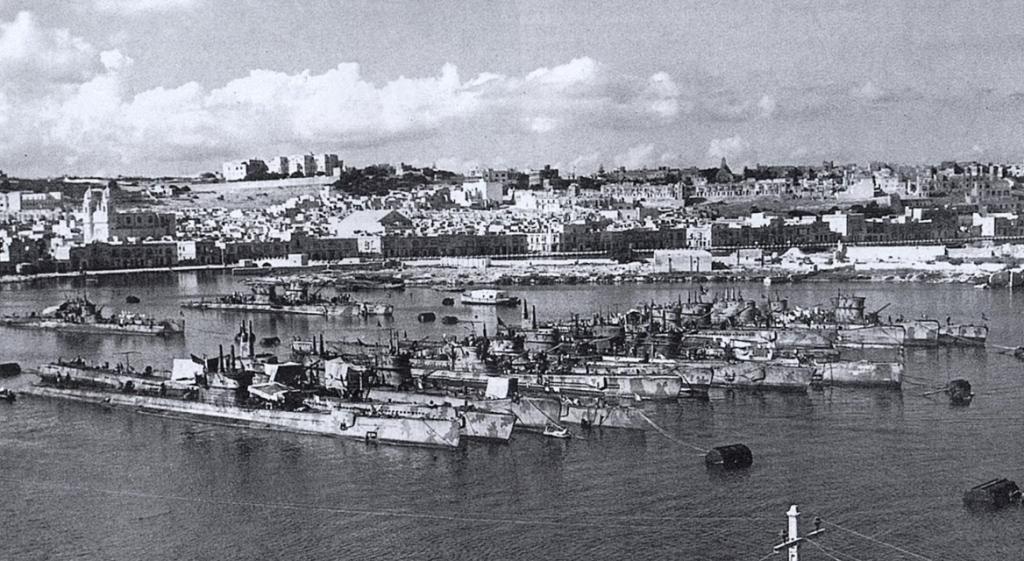
The Italian submarines moored in Lazaretto Creek (Marsa Muscetto), Malta
September 16th, 1943
Squalo left Augusta at sunset, along with five other submarines (Settembrini, Bragadin, Vortice, Onice, Zoea), to reach Malta, where almost all the Italian fleet had converged. Immediately outside the port of Augusta, the submarines dove, to avoid the risk that allied units, spotting them, could accidentally attack them considering enemies. They have been given instructions on approach routes that are supposedly free of mines (but there was no absolute certainty that there are none, as a German minefield was discovered again on September 6th).
September 17th, 1943
After submerging from Augusta to off the Maltese coast, Squalo and the other submarines resurfaced southeast of Malta in the afternoon, and reached the island at 6.35 PM, then moored in the innermost part of the anchorage of Lazaretto Creek (Marsa Muscetto). A total of sixteen Italian submarines gathered here.

The Shark at anchor in St. Paul’s Bay, Malta, September 22nd. 1943
(Imperial War Museum)
September 21st, 1943
Following the division (motivated by logistical reasons) into two groups of the Italian submarines located in Malta, Squalo was transferred to the mooring of San Paolo/Sliema (Malta), together with ten other submarines (Brin, Alagi, Galatea, H 1, H 2, H 4, Onice, Menotti, Jalea and Zoea), “relying” on the support ship Giuseppe Miraglia.
October 13th, 1943
Following Italy’s declaration of war on Germany, Squalo and almost all the Italian submarines in Malta (Brin, Bandiera, Settembrini, Jalea, H 1, H 2, and H 4; some others were sent to Haifa) left the island to return to Italy.
November 20th, 1943
Squalo reaches Augusta.
1944-1945
During the co-belligerence between Italy and the Allies, until the end of the conflict, Squalo (initially under the command of Lieutenant Alfredo Fellner and then of Sub-Lieutenant Fernando Ubaldelli) was intensively used in anti-submarine exercises for the training of both Italian Navy and Allied Marine units, based in Taranto and Augusta.

Squalo in Taranto (probably in 1944) docked next to the Ciro Menotti, at the time already out of commission
At the end of the war, it was laid up for decommissioning.
February 1st, 1948
The submarine was removed from the roles and set to the scrapyard.
Original Italian text by Lorenzo Colombo adapted and translated by Cristiano D’Adamo
Operational Records
| Type | Patrols (Med.) | Patrols (Other) | NM Surface | NM Sub. | Days at Sea | NM/Day | Average Speed |
|---|---|---|---|---|---|---|---|
| Submarine – Medium Range | 42 | 18800 | 2754 | 170 | 126.79 | 5.28 |
Actions
| Date | Time | Captain | Area | Coordinates | Convoy | Weapon | Result | Ship | Type | Tonns | Flag |
|---|---|---|---|---|---|---|---|---|---|---|---|
| 7/24/1941 | 23:01 | T.V. Ludovico Grion | Mediterranean | 32°20’N-24°53’E | Torpedo | Failed | Unknown | Tanker | United Kigdom |
Crew Members Lost
| Last Name | First Name | Rank | Italian Rank | Date |
|---|---|---|---|---|
| Mazzucchelli | Battista | Naval Rating | Comune | 7/31/1941 |